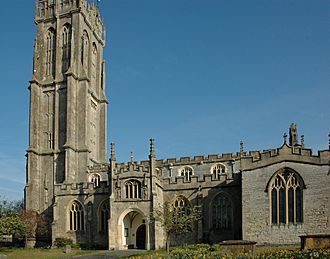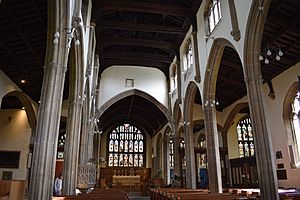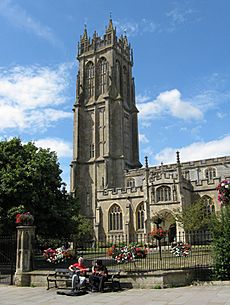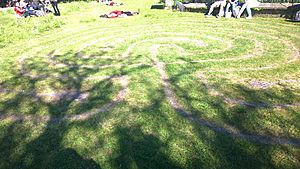Church of St John the Baptist, Glastonbury facts for kids
Quick facts for kids Church of St John the Baptist |
|
|---|---|
 |
|
| General information | |
| Town or city | Glastonbury |
| Country | England |
| Coordinates | 51°08′54″N 2°42′58″W / 51.1482°N 2.7162°W |
| Completed | 15th century |
The Church of St John the Baptist in Glastonbury, Somerset, England, is a very important and beautiful old church. It was built in the 15th century and is known as a Grade I listed building, which means it's a special historic place. People call it "one of the most ambitious parish churches in Somerset."
Contents
History of the Church
The church you see today was built after an older one. We have records of St John's from the late 1100s. However, other clues suggest a church stood here much earlier.
Early Beginnings
Legend says that Saint Dunstan built the first church here in the 900s. Digs inside the church have found old foundations. These show a large central tower that might be from Saxon times. There was also a Norman (from the time of the Normans) nave arcade, which is a row of arches.
This central tower lasted until the 1400s. It is thought to have fallen down, and that's when the church was rebuilt. In one part of the church, called the north aisle, you can still see parts from the 1100s in what was Saint Katherine's Chapel.
A Place of Shelter
The church has seen some interesting events. In June 1685, soldiers from Monmouth Rebellion used the church for shelter. Also, between 1800 and 1804, French prisoners of war were kept inside the church overnight four times. This likely happened when they were being moved from one place to another.
Restoration and Design
Between 1856 and 1857, the church was repaired and updated by Sir George Gilbert Scott. This work cost £3000 and made the church look even more like a Perpendicular Gothic building. This style of architecture is known for its tall, straight lines and large windows.
The church is built from different local stones, like Doulting stone and Street stone. It is shaped like a cruciform (a cross) when you look at it from above. It has a main area called a nave with aisles on the sides and a high row of windows called a clerestory.
Inside the Church
Inside the church, you can find many old and interesting things. There are four tomb-chests from the 1400s. You can also see some beautiful stained glass windows from the 1400s in the chancel (the area near the altar).
The church also has medieval vestments (special clothes worn by priests). There is even an old cupboard from around 1500 that used to be in a place called Witham Charterhouse.
Artworks by Ernst Blensdorf
At the front of the tower, there are two large carvings. One is called 'Madonna with Child' and the other is 'Resurrection Christ'. These were made in 1945 by an artist named Ernst Blensdorf. They were some of his first works after he escaped from the Nazis.
Tower and Bells
The church's west tower is very impressive. It has fancy buttressing (supports), panels, and battlements (the top part that looks like a castle wall). The tower stands 134½ feet (about 41 metres) tall. It is the second tallest parish church tower in Somerset.
Tower's Influence
The current tower was built in the 1400s, replacing an older central tower. This tower is said to have inspired many other church towers, like the one at Northington Parish Church. An interesting fact about this tower is that it has a clock that chimes, but it doesn't have a clock face to show the time!
The Church Bells
St John's Church has had bells since 1403. The oldest bell still there was first made in 1612. It had a special message carved on it: 'I sound to bid the sick repent in hope of life when breath is spent'. This bell was remade in 1992.
In 1878, the set of six bells was made into a set of eight. The largest bell, called the tenor bell, weighs about 712 kilograms. The smallest bell, called the treble, weighs about 250 kilograms.
Churchyard Features
The churchyard is a peaceful place with some unique features.
The Glastonbury Thorn
You can find a thorn tree in the churchyard. This tree grew from a cutting of the famous Glastonbury Thorn. Every Christmas, a blossom from this tree is sent to the King or Queen.
Children from St John's Infants School gather around this tree each year. They sing carols, including one written just for the occasion. The oldest student gets to cut the branch of the Glastonbury Thorn that is then sent to London.
The Tercentennial Labyrinth
Near the church gates, there is a special grass labyrinth. It was created in 2007 to celebrate Glastonbury getting its town charter from Queen Anne in 1705. A charter is like a special document that gives a town certain rights.
This labyrinth has a classic seven-circuit design. Its path is marked by blue lias stonework, which is a local stone found in the Tor (a nearby hill). A local expert named Sig Lonegren designed this labyrinth.
Church Leadership
The church has had many vicars (the main priest) over the years.
Notable Vicars
- Thomas Parfitt was the longest-serving vicar of Glastonbury. He was in charge for more than 52 years, from 1812 until he passed away in 1865.
- Charles Sydenham Ross became vicar in 1865. He was known for being born at sea off the coast of Portugal. He passed away during a church service on Christmas Eve in 1893.
- Henry Lowry Barnwell served as vicar for 18 years until 1912. A beautiful oak screen was put in the side chapel to remember him.
- Charles Victor Parkerson Day volunteered as a chaplain during World War One. He spent more than half of his nine years as vicar serving in war areas like France.
- Lionel Smithett Lewis became vicar in 1921. He was very interested in the legends of the Holy Grail and Joseph of Arimathea. He also helped start Blue Cross, an animal charity.
Current Ministry
The current vicar of Saint John's, Glastonbury, is the Reverend David MacGeoch. He works with the Reverend Robin Ray and a team of lay readers (people who help with church services but are not ordained priests).
St John's Church is linked with St Benedict's Church in Glastonbury and St Mary's & All Saints Church in the village of Meare. They work together as a joint group of parishes.
Music at St John's
The church has a strong tradition of music and works closely with the nearby Cathedral of Wells. A robed choir and processions were first started at St John's by Charles Sydenham Ross in 1865.
Today, St John's choir has many adults and young people. They are led by Matthew Redman, who is the organist and choirmaster. The choir is so good that they often sing in famous cathedrals like Exeter, Salisbury, Hereford, and Wells.
The church also has a special scholarship with the Cathedral School in Wells. Each year, a student who plays the organ is chosen to work with the Director of Music. This helps them gain experience working in a parish church.
See also
- List of Grade I listed buildings in Mendip
- List of towers in Somerset
- List of ecclesiastical parishes in the Diocese of Bath and Wells




